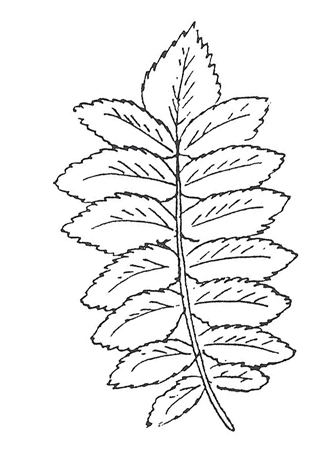Sorbus aucuparia (sor’-bus aw-kew-pay’-ree-a)
Family: Rosaceae, Rose
Key Steps
- 1b – Alternate leaf arrangement — go to 18
- 18b – Leaf compound — go to 58
- 58b – More than 3 leaflets — go to 59
- 59c – Leaflet margins are medium-serrate — go to 64
- 64b – Solid pith — go to 65
- 65a – Leaflets up to 2 ½ inches long; all of uniform size. No milky sap from cut stem — European Mountain Ash
- 64b – Solid pith — go to 65
- 59c – Leaflet margins are medium-serrate — go to 64
- 58b – More than 3 leaflets — go to 59
- 18b – Leaf compound — go to 58
Description
 Leaf: Leaflet: 9-19, small, each 3/4 to 2 1/2 inches long. Toothed margin upper 2/3 of leaflet. Lower 1/2 margin may be smooth. Oval shaped, short, pointed tip. May be hairy. Leaf 5-7 inches long.
Leaf: Leaflet: 9-19, small, each 3/4 to 2 1/2 inches long. Toothed margin upper 2/3 of leaflet. Lower 1/2 margin may be smooth. Oval shaped, short, pointed tip. May be hairy. Leaf 5-7 inches long.
Bud: Terminal buds are long (over 1/4 inch), tapered, pointed at end, slightly twisted. Scales open up to expose grayish-white hairs. The hairyness give the bud the appearance of a rabbit’s foot. Lateral buds are smaller, reddish-brown.
Leaf Scar: Narrow, raised, V-shaped. 5 bundle scars.
Stem: Reddish-brown, woolly, light lenticels.
Bark: Shiny, orange-brown, very attractive.
Pith: 5-sided or roundish, brown, continuous.
Flower: 5 creamy white petals in May. Large, upright, flat-topped clusters, 4-6 inches wide.
Fruit: Large clusters of bright reddish-orange, 1/4 inch diameter berries.
Habit: Small ornamental tree. Upright, oval. 25 feet tall by 14 feet wide. Short-lived (20-30 years).
Culture: Moderate moisture requirement. Full sun. Prone to fireblight.
Sorbus scopulina — Colorado native in cool ravines from foothills to sub-alpine zones. Multi-stemmed shrub or small tree.
Resources




